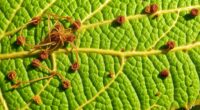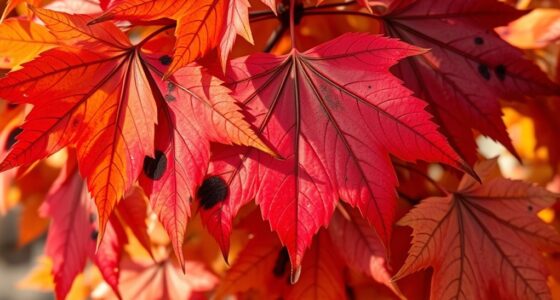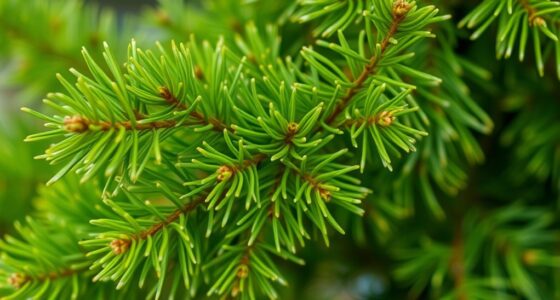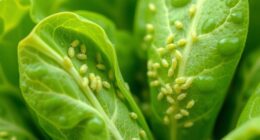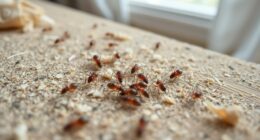Yellowing leaves on your skip laurel often point to issues like nutrient deficiencies, overwatering, poor soil drainage, pests, or diseases. Check for signs such as spots or webbing, and assess your watering routine and soil health. Proper pruning, balanced fertilization, and early pest control can help revive your plant. To guarantee healthy growth and prevent future problems, you’ll find more detailed solutions if you explore further.
Key Takeaways
- Yellowing leaves may indicate nutrient deficiencies, overwatering, or pests; proper diagnosis is essential.
- Check for pests like webbing or sticky residue, and treat with targeted insecticides if present.
- Ensure balanced fertilization and avoid over-pruning to reduce plant stress and promote healthy foliage.
- Improve soil drainage and adjust watering habits to prevent root rot and nutrient uptake issues.
- Regularly inspect and remove infected or dead parts to prevent disease spread and support plant recovery.
Common Causes of Yellowing Leaves in Skip Laurel
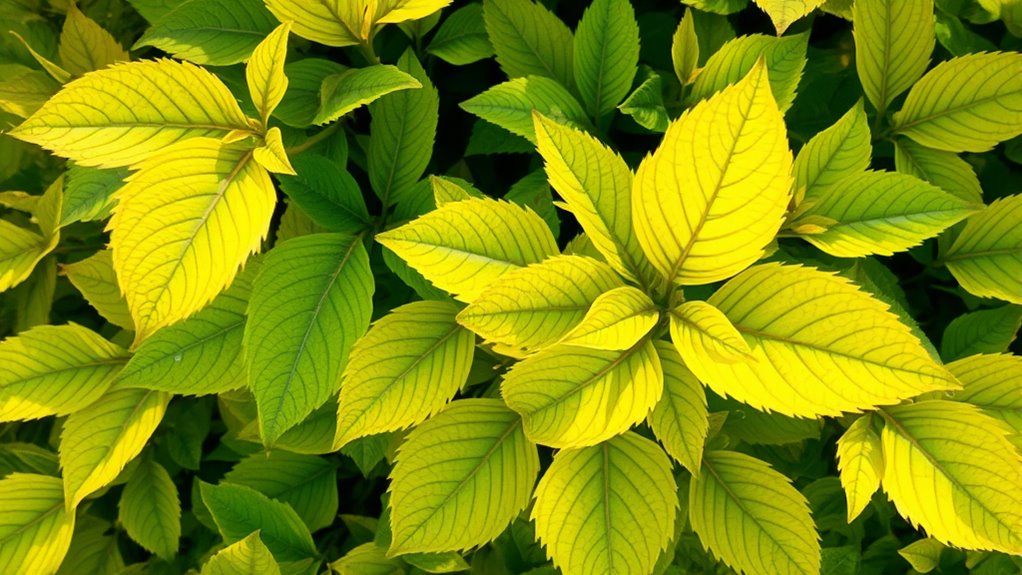
Yellowing leaves in your Skip Laurel can often be traced to several common issues. One key cause is improper pruning techniques, which can stress the plant and inhibit healthy growth. Over-pruning or cutting at the wrong time can weaken branches, leading to yellowing leaves. Additionally, inadequate fertilizer application limits essential nutrients, causing leaves to lose their vibrant color. Skip Laurels thrive with balanced fertilization during the growing season, supporting lush foliage. Regular pruning helps maintain airflow and shape, preventing disease and promoting healthy leaf development. Ensuring you follow proper pruning techniques and applying fertilizer correctly can markedly reduce yellowing. Furthermore, understanding plant nutrition and how it influences leaf color can help you address deficiencies more effectively. By addressing these issues early, you can keep your Skip Laurel healthy and vibrant, avoiding the common pitfalls that lead to discolored leaves.
Identifying Signs of Nutrient Deficiency
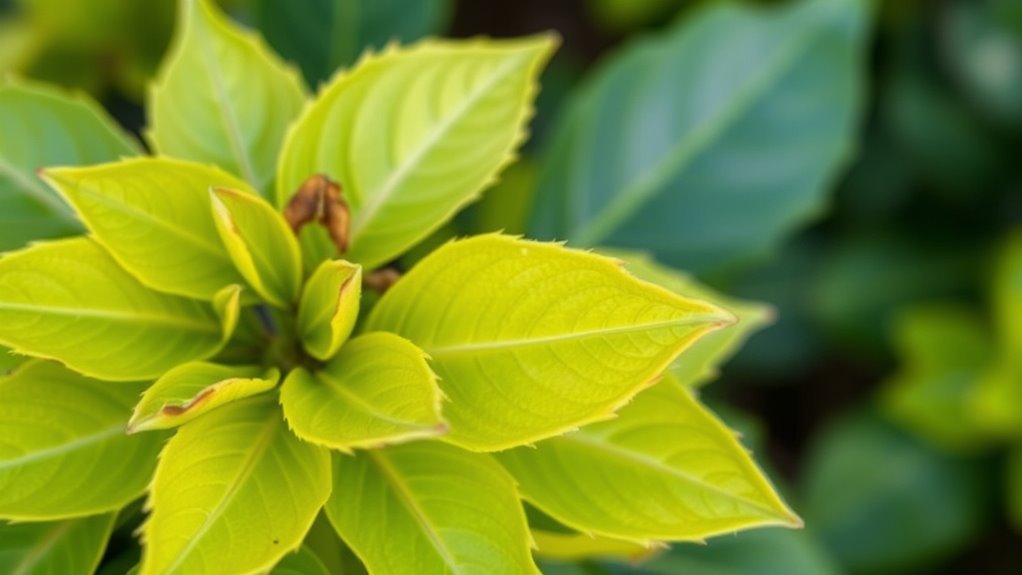
Recognizing nutrient deficiencies in your Skip Laurel is essential for maintaining healthy, vibrant foliage. Foliage discoloration is a key sign; yellowing leaves, especially on new growth, often indicate nitrogen deficiency. If you notice older leaves turning yellow first, it might be an iron deficiency, causing chlorosis. A nutrient imbalance can also lead to stunted growth or uneven leaf coloration. Look for signs like pale or mottled leaves, or a general decline in leaf vitality. Sometimes, the yellowing is accompanied by leaf drop or poor overall health. By closely observing these symptoms, you can identify which nutrients your plant is lacking. Correcting these deficiencies promptly will restore your Skip Laurel’s lush, green appearance and prevent further health issues.
Effects of Watering Habits and Soil Drainage
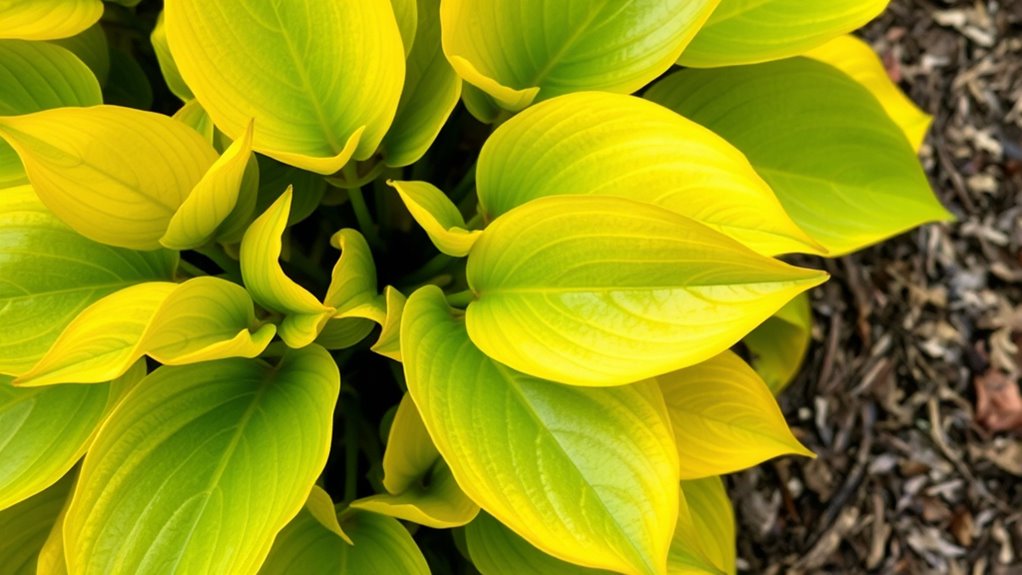
Overwatering can cause your skip laurels’ leaves to turn yellow and roots to rot. Poor soil drainage worsens these problems, trapping excess water around the roots. Ensuring proper watering habits and well-draining soil helps keep your plant healthy.
Overwatering Consequences
When you water your Skip Laurel leaves excessively, it can lead to serious problems for the plant’s health. Overwatering causes root rot, which hampers nutrient uptake and results in yellowing leaves. To prevent this, focus on proper pruning techniques to remove damaged roots and improve airflow. Be cautious with fertilizer types; over-fertilizing with high-nitrogen formulas can compound stress. Visualize the consequences:
- Roots submerged in soggy soil, decaying and turning brown
- Leaves turning yellow, wilting despite moisture
- Soil staying moist long after watering, indicating poor drainage
Consistently overwatering weakens the plant, making it vulnerable to pests and disease. Adjust watering habits to allow soil to dry out slightly between waterings, promoting healthy growth.
Soil Drainage Issues
Poor soil drainage can profoundly impact your Skip Laurel’s health, especially if your watering habits keep the soil consistently wet. Excess moisture creates a perfect environment for root rot, which weakens the plant and causes yellowing leaves. To improve drainage, consider adding soil amendments like organic compost or sand to loosen compacted soil. These amendments help excess water flow away from the roots, reducing the risk of rot. Adjust your watering schedule to avoid overwatering, allowing the topsoil to dry out slightly between waterings. Proper drainage promotes healthy root development and keeps your Skip Laurel vibrant. Consistently wet soil hampers nutrient uptake, so addressing drainage issues is essential for preventing leaves from turning yellow and ensuring your plant thrives. Additionally, understanding the effects of watering habits and soil drainage can help prevent recurring problems and maintain your plant’s vitality. Being mindful of moisture levels and how they affect plant health is key to successful care.
Recognizing Pest Infestations and Disease Symptoms
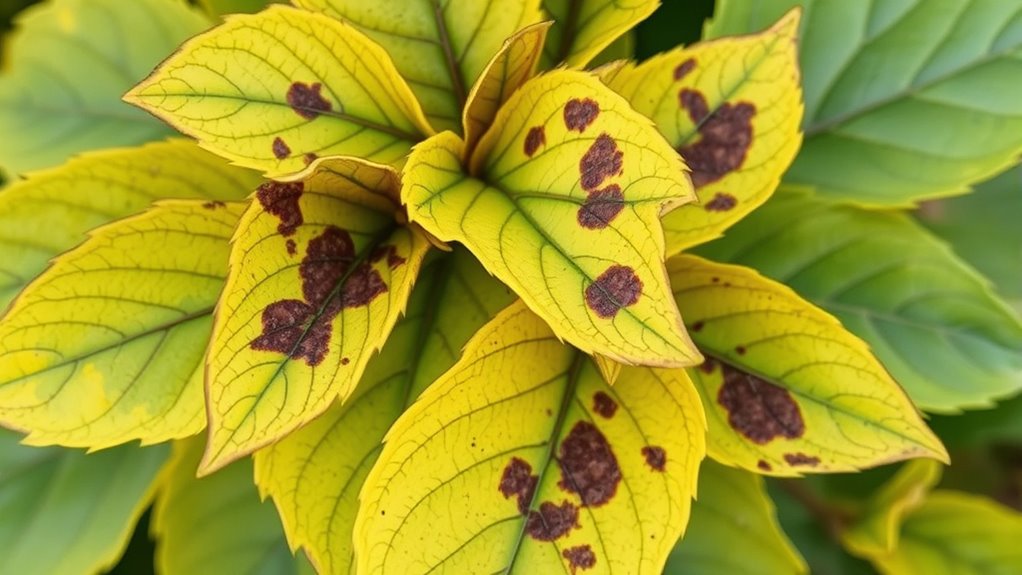
To keep your skip laurels healthy, you need to spot pest signs and disease symptoms early. Look for unusual spots, wilting, or discolored leaves that don’t match watering issues. Understanding the differences helps you take the right action quickly. Additionally, monitoring for signs of cultural impact can help you prevent further plant stress and damage. Regularly inspecting for pest infestations such as aphids or scale can also aid in early detection and treatment, which is essential for maintaining optimal indoor air quality around your plants.
Identifying Pest Indicators
Recognizing pest indicators is essential for maintaining healthy skip laurels, as early detection can prevent severe damage. Look for telltale signs like tiny webs, sticky residue, or discolored spots on leaves. You might notice pests crawling on stems or leaves, or see distorted, yellowing foliage indicating an infestation. To manage pests effectively, use proper pruning techniques to remove affected areas and improve airflow. Mulching benefits include preventing weed growth that might harbor pests or disease. Keep an eye out for:
- Small insects or eggs hiding beneath leaves
- Chewed or ragged leaf edges
- Unusual sticky or shiny patches on foliage
Early identification allows you to act swiftly, reducing the need for harsh treatments and keeping your skip laurels healthy and vibrant. Additionally, understanding the pest indicators can help you implement targeted treatments before significant damage occurs, especially since wall organization systems can also create hiding spots for pests if not properly maintained. Being aware of projector technology can also guide you in choosing the right tools for effective pest control, as certain environments may require specific solutions.
Disease Symptom Signs
Identifying disease symptoms on skip laurels is vital for catching problems early before they cause significant damage. Look for discolored or wilting leaves, black spots, or unusual growths. These signs indicate potential fungal or bacterial infections. Proper pruning techniques help remove infected areas, preventing disease spread. Mulching benefits include maintaining soil moisture and reducing weeds, which can harbor pathogens. Use the table below to recognize disease symptoms:
| Symptom | Possible Cause | Action |
|---|---|---|
| Yellowing leaves | Root rot or nutrient deficiency | Improve drainage, fertilize |
| Black spots | Leaf spot disease | Remove affected leaves |
| Wilting stems | Fungal infection | Prune infected stems, apply fungicide |
Early detection allows you to act swiftly, protecting your skip laurel’s health and vibrancy. Additionally, understanding disease symptoms helps in implementing effective prevention strategies, such as maintaining proper plant care. Regular monitoring and sound diagnostics can help identify issues before they become severe.
Differentiating Pest vs. Disease
While both pests and diseases can cause similar symptoms on skip laurels, understanding their differences is key to effective treatment. Pests often leave tiny holes, webbing, or sticky residue, while diseases may cause spots, discoloration, or wilting. To identify pests, look for:
- Small insects crawling or flying around the plant
- Webbing or sticky sap on leaves
- Chewed or deformed foliage
Diseases, on the other hand, tend to show:
- Irregular leaf spots or yellowing patches
- Fungal growth or mold on leaves or stems
- Wilting despite proper watering
Proper pruning techniques can remove infected parts, but applying the right fertilizer options boosts plant health, making skip laurels more resistant. Additionally, vetted product reviews can help you select the most effective pest control or disease management solutions. Effective pest management often involves targeted treatments like insecticidal soap or neem oil, while disease control may require fungicides or improved cultural practices. Correct identification guarantees you choose the right treatment, whether pest control or disease management.
Practical Solutions to Revive Your Skip Laurel
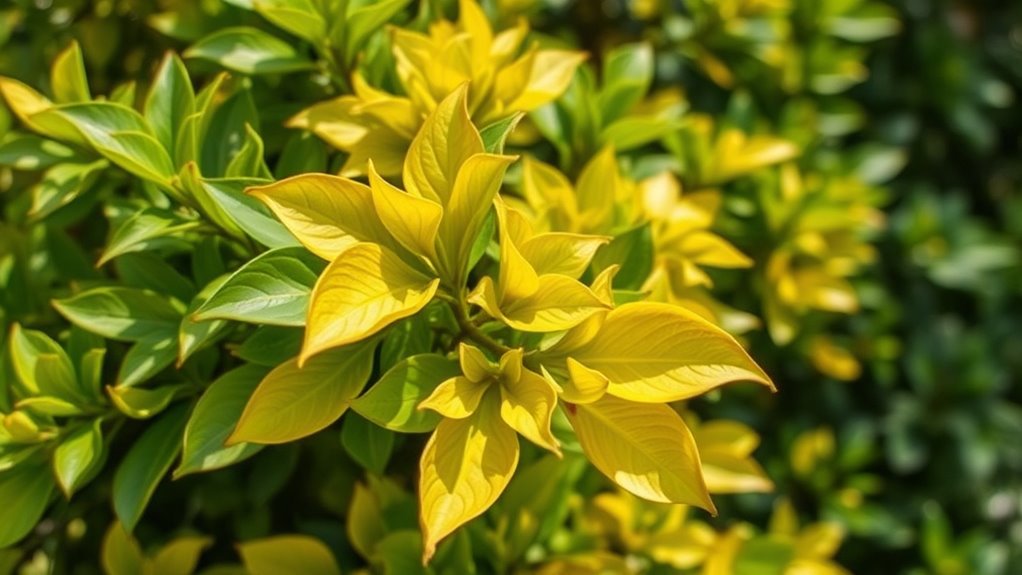
If your skip laurel leaves are turning yellow, quick action can help restore their health. Start with proper pruning techniques to remove any dead or diseased branches, encouraging new, healthy growth. Be careful not to over-prune, as this can stress the plant further. Next, evaluate your fertilization approach; use a balanced fertilizer with nitrogen, phosphorus, and potassium to boost leaf color and overall vigor. Organic options like composted manure or slow-release granular fertilizers work well. Apply fertilizer according to package instructions, avoiding excessive feeding that can cause nutrient imbalance. Regular watering and mulching also support recovery. By combining targeted pruning with appropriate fertilizer types, you’ll give your skip laurel the best chance to recover and regain its lush, green appearance. Additionally, understanding plant health signs can help you identify and address underlying issues early on. Ensuring proper nutrient balance is crucial to prevent yellowing leaves and promote vibrant growth.
Preventative Measures for Healthy Growth
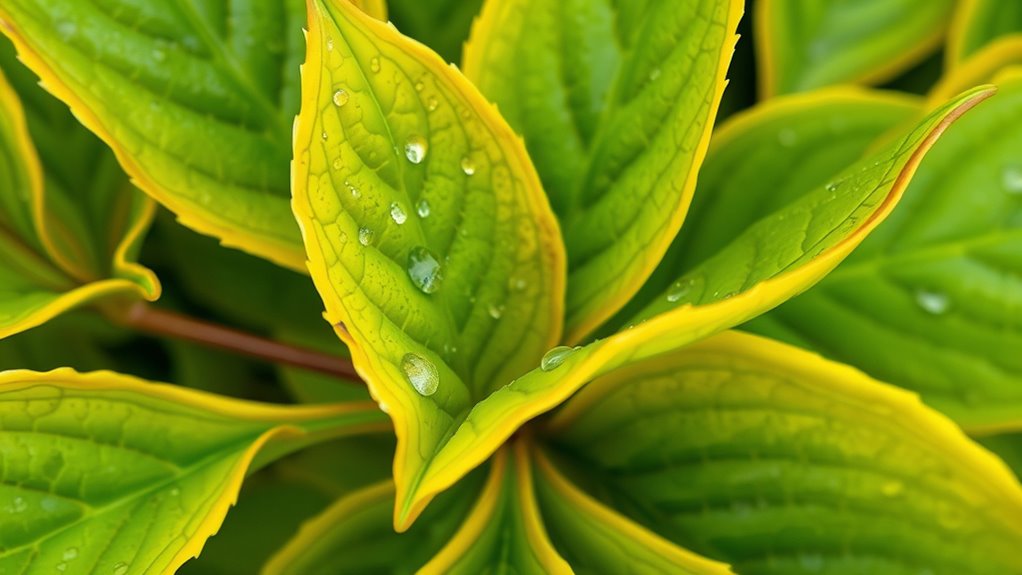
Preventative measures are essential to keep your skip laurel healthy and thriving. Regular pruning techniques help maintain its shape and remove dead or diseased branches, preventing issues before they start. Applying mulch around the base offers mulching benefits like retaining soil moisture, regulating temperature, and suppressing weeds, all supporting strong growth. To encourage healthy development, visualize your plant with:
- Neatly trimmed branches that allow sunlight to reach all parts
- A thick layer of mulch creating a cozy, moisture-retentive blanket
- Consistent watering to keep roots hydrated and vibrant
- Incorporating gardening tools can help organize gardening supplies, making maintenance easier and more efficient. Using appropriate fertilization can also promote lush foliage and overall plant vigor.
Frequently Asked Questions
How Often Should I Fertilize Skip Laurels for Optimal Health?
You should fertilize your skip laurels about twice a year to maintain a good fertilizer schedule. Use a balanced, slow-release fertilizer to guarantee the right nutrient balance. Apply it in early spring and mid-summer, avoiding over-fertilizing, which can cause yellowing leaves. Proper fertilization encourages healthy growth and vibrant foliage, so stick to this schedule and adjust if you notice signs of nutrient deficiency or excessive growth.
Can Environmental Stress Cause Yellowing Leaves in Skip Laurels?
Drought stress and soil compaction can definitely cause yellowing leaves in your skip laurels. When water wanes or soil becomes tightly packed, roots struggle to access nutrients, leading to lilting leaves. You might notice that dry days or heavy foot traffic compact the soil, suffocating roots. To revive your plant, water consistently and aerate the soil, allowing roots to breathe and absorb essential nutrients, bringing back its vibrant, verdant energy.
Are There Specific Pests That Target Skip Laurels More Than Others?
You should know that certain pests, like scale insects and aphids, tend to target skip laurels more than others. To keep your plant healthy, practice pest identification regularly so you can spot issues early. Use insect prevention methods such as neem oil or insecticidal soap, and remove pests manually if possible. Staying vigilant helps prevent pest infestations from causing yellowing leaves or other damage to your skip laurel.
How Long Does It Take for Skip Laurels to Recover After Treatment?
After treatment, your skip laurel’s recovery timeline varies based on factors like the severity of the issue and treatment type. Generally, you’ll see new growth within a few weeks, but full recovery could take several months. Consistent care, proper watering, and addressing underlying problems help speed up recovery. Keep monitoring your plant’s response, and with patience, you’ll notice healthier leaves and renewed vigor over time.
Is It Safe to Prune Yellow Leaves From My Skip Laurel?
Pruning safety is key when removing yellow leaves from your skip laurel. You can safely prune these leaves, as it helps improve the plant’s health and appearance. Just use clean, sharp tools and make clean cuts to prevent damage. Leaf removal of yellow or dead foliage encourages new growth and prevents disease. Avoid over-pruning, and always prune during the right season for best results.
Conclusion
To keep your skip laurel thriving, address issues like nutrient deficiencies, proper watering, and pest control promptly. Regular care can boost its health and prevent yellowing leaves. Did you know that over 60% of plant problems stem from improper watering? By staying vigilant and applying the right solutions, you’ll enjoy lush, green foliage year-round. With these tips, your skip laurel will stay vibrant and healthy, enhancing your garden’s beauty for years to come.

